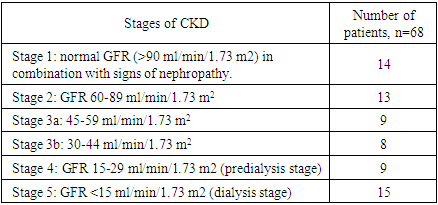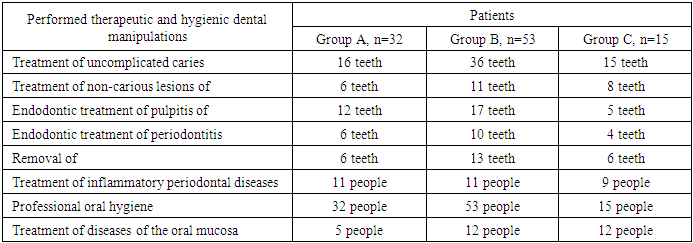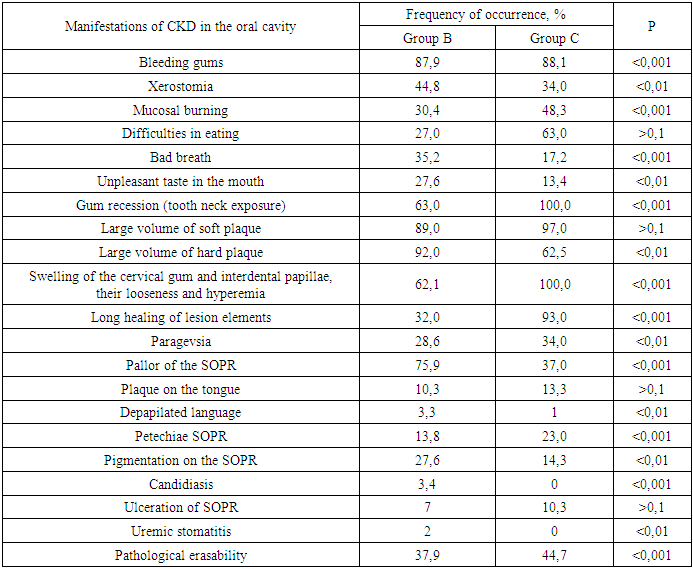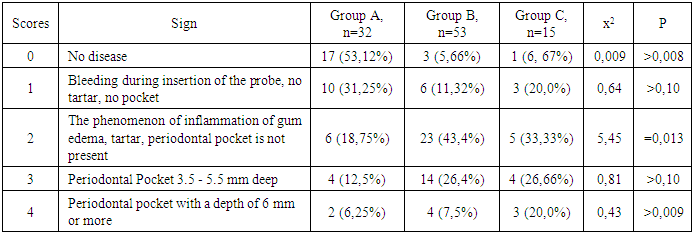-
Paper Information
- Next Paper
- Previous Paper
- Paper Submission
-
Journal Information
- About This Journal
- Editorial Board
- Current Issue
- Archive
- Author Guidelines
- Contact Us
American Journal of Medicine and Medical Sciences
p-ISSN: 2165-901X e-ISSN: 2165-9036
2022; 12(9): 878-885
doi:10.5923/j.ajmms.20221209.05
Received: Aug. 4, 2022; Accepted: Aug. 28, 2022; Published: Sep. 15, 2022

The Relationship of Chronic Kidney Disease with the Condition of the Oral Cavity
Rizaev J. A., Husanbaeva F. A.
Samarkand State Medical University, Samarkand, Uzbekistan
Correspondence to: Rizaev J. A., Samarkand State Medical University, Samarkand, Uzbekistan.
| Email: |  |
Copyright © 2022 The Author(s). Published by Scientific & Academic Publishing.
This work is licensed under the Creative Commons Attribution International License (CC BY).
http://creativecommons.org/licenses/by/4.0/

The article describes the prevalence and intensity of dental diseases in patients with CKD in Uzbekistan. The study involved 100 people, including 68 patients with CKD, of which 15 patients received hemodialysis. 32 practically healthy people made up the control group. The results obtained after the application of standard dental treatment are presented: data on the intensity and prevalence of caries, the dynamics of the hygienic condition, periodontal status and the state of the oral mucosa, assessment of the condition of fillings in patients with CKD.
Keywords: Caries, Prevalence, Intensity, Non-carious lesions, Periodontal disease, COPD, Dentistry, Chronic kidney disease, CKD
Cite this paper: Rizaev J. A., Husanbaeva F. A., The Relationship of Chronic Kidney Disease with the Condition of the Oral Cavity, American Journal of Medicine and Medical Sciences, Vol. 12 No. 9, 2022, pp. 878-885. doi: 10.5923/j.ajmms.20221209.05.
Article Outline
1. Introduction
- Almost all chronic diseases of the body are associated with poor oral health, which leads to the need for better dental care. This is especially evident in patients with chronic kidney diseases, where oral diseases are a potential cause of deterioration of their already fragile health [18,19].Existing data on the prevalence and severity of oral diseases in patients with chronic kidney disease are limited to small samples. Studies show various cases of oral diseases in such patients. However, based on these scant data, it is estimated that almost 90% of patients with chronic kidney diseases show some symptoms of oral diseases, especially gum hyperplasia, xerostomia and changes in salivation and saliva composition [4].Patients with chronic kidney diseases require special attention from the dentist due to multiple manifestations in the oral cavity, side effects and treatment features of the underlying disease [4].The treatment of CKD is the treatment of a polymorbid patient, simultaneously aimed at slowing down the progression of kidney dysfunction (renoprotection) and preventing the development and progression of cardiovascular pathology (cardioprotection) in order to improve the prognosis. The commonality of the causes and mechanisms of damage to the kidneys and the cardiovascular system (hyperactivation of the renin-angiotensin system, expression of inflammatory mediators and fibrogenesis factors) gives grounds for recommending drugs with reno- and cardioprotective effects - blockers of the renin-angiotensin-aldosterone system: angiotensin-converting inhibitors enzyme or angiotensin II receptor blockers. In addition, these drugs have antioxidant and anti-inflammatory activity.The need to study the manifestations of CKD in the oral cavity in patients in Uzbekistan served as the purpose of this study.Materials and methods of research. The study involved 100 people, including 68 patients with CKD, of which 15 patients received hemodialysis. 32 practically healthy people made up the control group. The age of the patients was 45-56 years. Men - 58, women - 42 people. The study took place in 2020-2022 on the basis of Samarkand State Medical University, Tashkent State Dental Institute.Criteria for inclusion in the study: therapeutic patients with inflammatory diseases of the endo- and periodontium (acute and chronic pulpitis, chronic generalized catarrhal gingivitis and chronic generalized periodontitis) with concomitant chronic kidney pathology. Exclusion criteria: patients with a decrease in glomerular filtration rate <15 ml/min/1.73 m2.The patients were divided into the following groups:1. A group of people who do not have pathology from the urinary system - 32 people (group A);2. Patients with chronic kidney disease who are not being treated on hemodialysis - 53 people (group B);3. Patients with chronic kidney disease undergoing hemodialysis treatment - 15 people (group B).
|
|
2. Results of the Dental Status Study
|
|
|
|
|
|
|
3. Prevalence of Non-Carious Dental Lesions
|
|
4. Study of the Periodontal Condition
- In patients with CKD, inflammatory processes of periodontal tissues are common. Their occurrence is shown in Table 12.
|
|
5. Discussion of the Results of the Study of Dental Status
- We found that in all groups of patients with CKD, the prevalence and intensity of caries were higher than in those without urological diseases. The data obtained by us indicate that all patients with CKD have an unsatisfactory hygienic level of the oral cavity, which coincides with the research data of many authors. As a result, after the preventive measures carried out a year later, the prevalence of caries in group A was 63.6% (an increase of 2.8% compared to the initial examination), the intensity of caries changed this time period from 5.96 ± 0.31 to 6.2±0.41 (p<0.01), the increase in caries was 4.02%;. Examination after 12 months revealed the number of carious teeth equal to an average of 1.28 ± 0.13.When examining patients in group B a year later, the increase in the prevalence of caries was 5.2%, with an intensity of 6.6 ± 0.43, the increase in the intensity of caries was 3.6%.In group B, the increase in the prevalence of caries after 12 months was 5.4%. The intensity was 7.26 ± 0.43, the increase in the intensity of caries was equal to 3.71%.Minor changes in the prevalence and intensity of dental caries clearly demonstrate to us that in patients with CKD, these indicators are greatly affected by an increased level of urea in saliva, even despite a decrease in the mineralizing properties of oral fluid and a deterioration in the hygienic condition of the oral cavity.So, if during the examination a week after cleaning, the hygiene index in group B was detected at the level of 1.2 ± 0.23 (during the initial examination, before cleaning - 2.3 ± 0.18), then after 12 months it was 1.8± 0.16 (an increase of 50%).We can observe similar results in group B. At the initial examination, the hygiene index was 2.52 ± 0.23, a week after cleaning - 1.35± 0.35, and a year later it increased to 2.1± 0.17 (an increase of 55.55%).While in group A, an increase in the hygiene index occurred by 38.5% - from 0.7± 0.14 a week after cleaning to 0.97±0.12 a year later.The deterioration of the hygienic condition in groups with CKD after a year is the result of deterioration of the processes of natural self-purification, a decrease in the activity of local immunity. In this regard, we believe that doctors should motivate patients to perform individual hygiene procedures.Pathological erasability of hard dental tissues (about 80% of patients with CKD) may be associated with uremia, which usually occurs in patients with CKD. It has been suggested that hypocalcemia, secondary to chronic kidney disease, which contributes to renal osteodystrophy, is one of the causes of non-carious lesions of the hard tissues of the teeth [25].Hyperpigmentation (27.6% and 14.3% in groups B and C) may probably be associated with insufficiency of beta-melanocytostimulating hormone secreted by the kidneys. As a result, excess melanin is deposited in the basal layer of the epithelium of the oral cavity [23].Swelling and pasty gums (62.1 and 100% in groups B and C, respectively) can be caused by drugs taken by patients, which can be divided into three main groups: anticonvulsants, immunosuppressants and calcium channel blockers. However, the exact cause of drug-induced gum hyperplasia is unknown; however, it is believed that this condition is associated with some risk factors that contribute to gum inflammation, such as poor oral hygiene, the presence of plaque, the dose and duration of the drug used [24].High levels of urea (16.34±0.88 and 27.24±0.83 mmol/L in groups B and C), dimethyl- and trimethylamines, and low levels of zinc may be associated with reduced taste perception in patients with uremia [25]. The increased concentration of urea, which is split by salivary urease into ammonia and carbon dioxide, gives a metallic, unpleasant taste [25]. The mechanisms underlying the changes in taste perception in patients with uremia are unknown, but they are probably related to the effect of uremic toxins on the central nervous system and peripheral nervous system (taste receptors) [14]. Gum bleeding was observed in 87.9 and 88.1% of patients with CKD and was associated with poor oral hygiene, periodontal inflammation [15].The burning sensation in the mouth, which was significantly higher in patients with CKD (30.4% in group B and 48.3% in group C), was associated with dry mouth, damage to peripheral nerves by urinary toxins and the effect of drugs [3,16].Complaints of xerostomia in patients with CKD (44.8 and 34.0% in groups B and C, respectively) are associated with fluid restriction, electrolyte imbalance, the use of certain medications such as furosemide and hydrochlorothiazide (antihypertensive agents), oral respiration, gland alteration (atrophy of the parenchyma of the small salivary glands), leading to a decrease in secretion saliva [20].35.2% and 17.2% of the participants in this study complained of halitosis (groups B and C, respectively). The uremic fetid odor or bad breath reported by patients with CKD is an ammonia odor that is caused by a high concentration of urea in saliva and is broken down to ammonia [22]. This is due to a reduced kidney function for the excretion of urea from the body, therefore, the concentration of urea in the blood (uremia) increases, as well as in saliva. In addition, patients with CKD often neglected oral hygiene [20].Pallor of the SOPR (75.9 and 37.0% in groups B and C) petechiae (13.8 and 23.0%) may be associated with anemia, be the result of anticoagulant therapy and/or platelet dysfunction [26].The prevalence of periodontitis (31.2 and 47.0% in groups B and C) in this patient population increases, most likely due to immunosuppression in uremia. This suppresses the inflammatory reaction of the gums when plaque accumulates [1]. Periodontitis is associated with increased values of other components of the acute phase of inflammation, including lower concentrations of high-density lipoproteins [12,13], increased amounts of low-density lipoproteins [14-16] and neutrophils [17]. Inflammatory periodontal lesions in patients with CKD occur against the background of dystrophic phenomena, which are significantly more common in patients receiving hemodialysis (p=0.027). Signs of periodontal disease are found in 37% of cases in patients with CKD and in 56% of cases in group B patients.Deterioration of the hygienic status of the oral cavity affects the aggravation of the degree of inflammation (p= 0.004). Elevated blood creatinine leads to the development of osteodystrophic phenomena and dystrophy in periodontal tissues. (p=0.03).Chronic kidney disease and paradontopathy are also associated with common risk factors such as diabetes mellitus [2], age and tobacco smoking [6]. It is believed that periodontal diseases are an unconventional risk factor for chronic kidney disease due to systemic changes caused by periodontal inflammation. Due to the periodontal presence of bacteria, inflammatory mediators such as interleukin-1, interleukin-6, prostaglandin 2 and tumor necrosis factor-alpha are locally produced, and their antigens can enter the bloodstream [9]. Studies have shown that compared with healthy people, patients with periodontitis may have an increased level of C-reactive protein and, as a consequence, a weakly expressed systemic acute-phase inflammatory reaction. Apparently, there is a mutual influence between periodontal diseases and chronic kidney diseases. Since the affected periodontal tissue is susceptible to chronic inflammation, it is likely that oral bacteria can affect the course of chronic kidney diseases. In patients with chronic kidney diseases, a greater number of periodontal red complex bacteria (P. gingivalis, T. forsythia, T. denticola) and C. albicans were detected, as well as significant destruction of periodontal tissue [18], as well as a greater number of periodontal bacteria (P. gingivalis, T. forsythia, P. intermedia and P. nigrescens, A. actonomycemconcomitans) in periodontal pockets in these patients [19]. Therefore, regular assessment and prevention of periodontitis are of particular importance for patients with chronic kidney diseases.The lesions detected in uremic stomatitis (2% in group B) were very painful and were most often localized on the lower surface of the tongue (81%). It manifested itself in the form of a gray pseudomembrane covering painful spots of erythema or red ulcers with a "purulent" cover.Studies on the state of periodontal disease in patients with CKD indicate poor oral hygiene (in patients with CKD of both groups, a large amount of soft and hard plaque was found) and gingivitis [4,6-10]. This is probably a consequence of a pronounced uremic syndrome associated with impaired immune function, as well as altered activity of lymphocytes and monocytes [11].The results obtained give us reason to assert that there is a need to develop a scheme for more effective treatment of dental diseases in patients with CKD, for which our research will continue.
 Abstract
Abstract Reference
Reference Full-Text PDF
Full-Text PDF Full-text HTML
Full-text HTML











